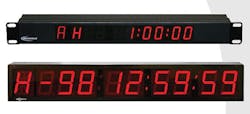Masterclock wins gold award for precision timing and time synchronization system
NASHUA, N.H., 12 Dec. 2016.Precision timing experts at Carl F Otto & Masterclock Inc. in Merritt Island, Fla., have received a gold award in the 2016 Military & Aerospace Electronics and Intelligent Aerospace Technology Innovation Awards for the company's Masterclock Timing and Countdown System for control and time synchronization.
The award to the Masterclock Timing and Countdown System is part of the middle of three tiers of this year's Technology Innovation Awards. The top award level is platinum, the middle tier is gold, and the third tier is silver.
Military & Aerospace Electronics and Intelligent Aerospace made awards to company entries that offer solutions to difficult aerospace and defense electronics design challenges. The awards were presented on 14 Nov. 2016.
The Masterclock Timing and Countdown System uses accurate real clocks instead of passive displays, as well as Ethernet and Masterclock software tools to provide switching, distribution, monitoring, and control of almost an unlimited number of clocks and event counts, company officials say.
Related: GPS jamming is a growing threat to satellite navigation, positioning, and precision timing
The Masterclock Timing and Countdown System provides users with remote computer control of their clocks and enables them to display selected event counts.
This system eliminates the need for special time code switching, several transmission paths, and distribution equipment in each facility. Users can monitor any of the clocks and control them remotely to display time or event counts from anywhere on the network.
In the past engineers had to provide separate transmission paths for time (IRIG B), local time, and several transmission circuits for each count, such as Test and L Time, company officials say. Each signal required distribution equipment in each facility.
The old system also required selecting which display received which time or count. This sometimes required manual intervention during events or required that a display be dedicated to only one type of signal otherwise dip switches had to be changed. This was difficult since the clocks are usually mounted up high so that they can be observed by all.
Installation of a clock required new coax or twin axial cables, dip switch settings and, if a new type of count was required, a new distribution amp card and transmission path had to be established to the facility from the launch control center.
NASA has used the system for timing at mission control and countdown at far-away locations such as Johnson Space Center in Houston, NASA headquarters in Washington, and NASA Wallops Island, Va., company officials say.
For more information contact Masterclock Inc. online at www.masterclock.com, or the Military & Aerospace Electronics and Intelligent Aerospace Technology Innovation Awards at www.militaryaerospace.com/innovators-awards.html.
Learn more: search the Aerospace & Defense Buyer's Guide for companies, new products, press releases, and videos
